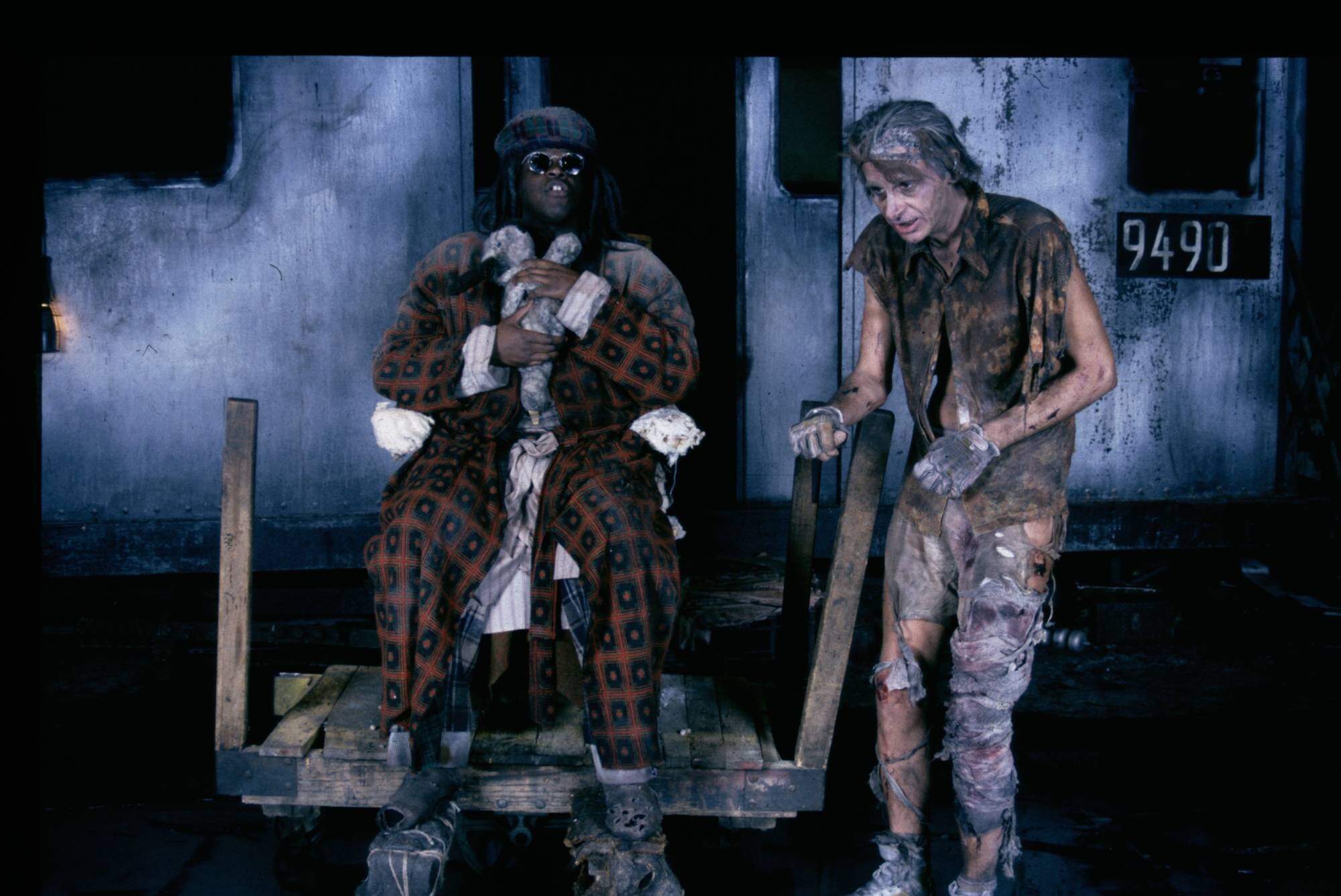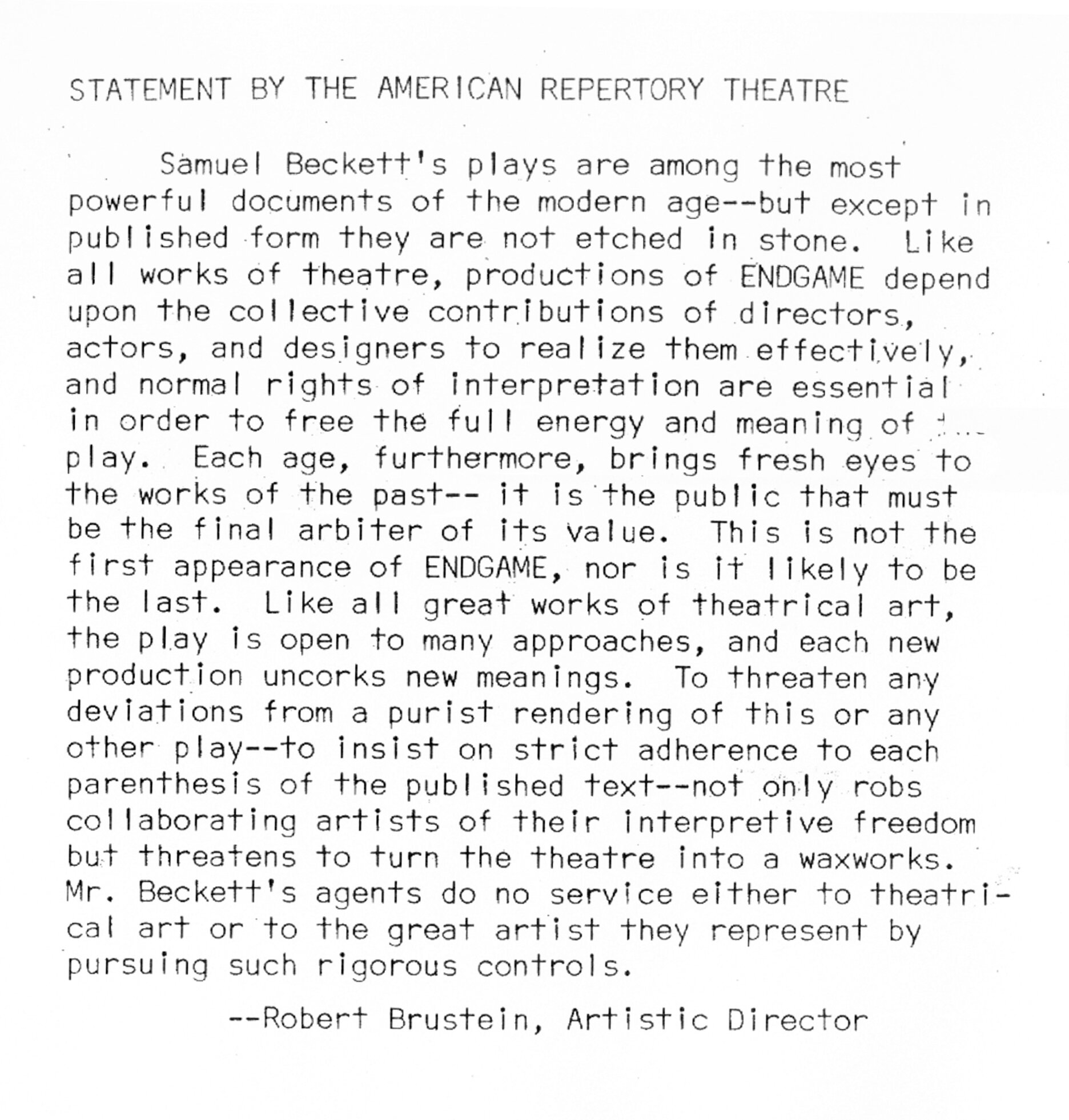Playwright vs. Director: Endgame and Virginia Woolf
In 1984 the director JoAnne Akalaitis staged a production at the American Repertory Theater of Samuel Beckett’s Endgame set in a post-Apocalyptic subway station.
Samuel Beckett didn’t like it.
Ben Halley Jr., John Bottoms
Courtesy of the American Repertory Theater / Photo: Richard Feldman
JoAnne Akalaitis is a five-time Obie-award winning director who was one of the founders of Mabou Mines in New York in 1970. At their start, Mabou Mines was the resident company at La MaMa Experimental Theatre Club in the East Village of New York City.
But back to Beckett. Oh, yes: Beckett didn’t like Akalaitis’s Endgame.
Just to clarify, Beckett didn’t see it. He objected to it before it premiered, based on reports which reached him that the production ignored his instructions as to what the set should look like.
Endgame, which premiered in 1957, four years after Waiting for Godot, is another four character play, and also considered a masterpiece. The blind and tyrannical Hamm, (who cannot stand), and his servant Clov (who cannot sit) play out this existential farce. The play also contains the characters of Hamm’s parents, who themselves are contained in ash cans at the back of the stage. The play calls for a “bare interior.”
Beckett contacted the ART through his agents and asked them to stop the production based on a few things. One was for ignoring Beckett’s stage directions. Another was using music in the show. Another was for casting black actors. But chiefly for ignoring his stage directions.
Artistic Director Robert Brustein went on record as saying that he revered Samuel Beckett over all living playwrights. (Beckett was 78 at the time). Brustein also responded to the playwright’s objections by saying that the play was absolutely faithful to the spirit of Beckett’s work and that not a line of text had been omitted or changed.
Ben Halley Jr., John Bottoms
Courtesy of the American Repertory Theater / Photo: Richard Feldman
Beckett didn’t agree. He tried to close the production before it opened.
The ART said, we are doing the production.
Beckett said, no you’re not.
The ART said, yes we are.
Beckett said, no you’re not.
(Well, you get the idea.)
After trying unsuccessfully to resolve it, the lawyers got involved. As it turns out, contractually, there was nothing that stipulated that any production had to follow his stage directions. So legally, Beckett had no grounds to shut the production down.
Shirley Wilber, Rodney Scott Hudson
Courtesy of the American Repertory Theater / Photo: Richard Feldman
Ultimately, this is what happened:
The ART agreed to remove Beckett’s name from all of the advertising. And in the ART’s program they would print Beckett’s stage directions as to how the set should look. Following that was a one-page statement from Beckett voicing his objections to the production. And following that was a statement from the ART defending the production.
And what do you know? I just happen to have a copy of these!
Ben Halley Jr., John Bottoms
Courtesy of the American Repertory Theater / Photo: Richard Feldman
The production was very well-reviewed and not seen as “a parody” at all. The New York Times said: “If we accept the metaphorical setting of the play to be a bunker in a world after the nuclear holocaust - a view that is supported in the text - then Miss Akalaitis could be credited with having made a defensible scenic interpretation. One man's cell could be another's graveyard…In her (Ms. Akalaitis's) hands, 'Endgame' has an intense dramatic drive as well as profundity.”
Post script: I believe that because of what happened at the ART, in all future productions of Endgame, the production contract prevents this kind of artistic interpretation and demands a rigorous adherence to the stage directions. So. There it is.
Edward Albee (I couldn’t afford an Albee photo so here is my artist’s conception. Hooray!)
I personally had a far-less dramatic and certainly not publicity-worthy experience in this realm shortly afterwards - but it was a big deal to me at the time. It was when I planned to direct Who’s Afraid of Virginia Woolf? by Edward Albee. In Virginia Woolf, the sparring, wolfish couple (George and Martha) invite the naive, lambish couple (Nick and Honey) to their house one night for what eventually becomes an evening of cruel games. Apparently, there had been a couple all-male productions of the play , each of which Albee sought to close, or shut down by legal action.
Albee, who referred to himself as a writer who happened to be gay (rather than a gay writer), repeatedly dismissed the theory that Virginia Woolf was a gay allegory. He said the idea was “ludicrous,” and that he was perfectly capable of writing gay characters if that’s what he wanted.
Probably because of this, when we applied for the rights to Virginia Woolf, the contract stated that Albee had to personally approve our cast.
Wow. Albee. Personally. Approve.
Not a stock photo. (but not the real resumes either)
So in February of that year I mailed him the photos and resumes of our four actors, which, for the record, were two men and two women. And who by the way, we had cast. This was pre-email, so everything happened by regular mail, fax, or phone calls.
I also had to mail Edward Albee my resume. I had only be directing professionally for a year, so my resume was much less impressive than the resumes for any of the actors. In fact, it wasn’t impressive at all. You could have written my directing CV on a fortune cookie slip. I had never needed to send my directing resume to anyone before this and now suddenly I was sending it to Edward Albee. My not-so-secret fear was that Albee would have no problem with the cast, but would prevent the production based on my lack of experience. Such is the way the mind works when you have to send your resume to Edward Albee for “approval.”
So I mailed off everything to New York in a manila envelope and waited.
After a month, we had not heard anything. So I called Albee’s agent and asked him for an update. There was no news. Two weeks later, getting nervous about being able to promote a summer show for which we had no rights, I called again.
“Mr. Albee is in Europe,” the agent told me. “I forwarded the materials to him.” And that was the end of that conversation.
I’m guessing he didn’t fax them but mailed the materials to him in Europe from New York. But what did I know? Two weeks later I’m on the phone again with the agent:
“He’s still in Europe,” said the agent, a little wearily.
“We go into rehearsal next month,” I said, trying to sound desperate and cheery at the same time, if such a thing was possible - and it wasn’t. “Isn’t this just a formality?” I went on trying to summon up all of my confidence and good will: “Surely you can see that the actors are suited to these parts.” I didn’t bring up the gender thing, but I think the agent knew what I was talking about. I was also trying to get the agent to do an end run around Albee’s process and just approve them himself - a gambit which the agent saw through immediately.
There was a dour pause on the other end of the line.
“Mr. Albee must approve the cast personally,” was all the agent said to me. And he really hit that last word with a shovel.
Well, Ok.
It was deep into May with no word; and it had been two or three months since I sent in those resumes. We had to promote the season. Plus, we were going into rehearsals next month. But I couldn’t go ahead and prepare for a show for which we had no rights. So I called the four actors and told them the situation and asked if I could put them in another play. Yes, but what? That was the slot in our season for an American play.
White River Theatre Festival: A Streetcar Named Desire. From left to right: Michael Friedman, Dan Yates (Stanley), Michael Poisson (Mitch), Mark Cartier, Deanna Dunmyer (Stella), and Mary Walworth (Blanche).
I finally decided to change the play to A Streetcar Named Desire. The Nick actor would play Stanley. Honey would play Stella, Martha would play Blanche, and George would play Mitch. This last one seemed like stretch, casting a witty, urbane actor as the simple working-class Mitch.
It also required casting (and paying) seven additional actors. Oh well.
So I scrapped Virginia Woolf and we did Streetcar and it was terrific to work on. The actor playing Mitch, by the way, was amazing in the role. A role I would not have thought to cast him in, without trying to climb out of the pickle we were in (if I may mix my metaphors). This was my first experience with the joys of casting against type.
So there it was, A Streetcar Named Desire: cast, rehearsed, promoted and performed.
And at the first performance of Streetcar, I received an opening night surprise: a letter arrived from New York saying that Edward Albee had approved our cast for Who’s Afraid of Virginia Woolf?










